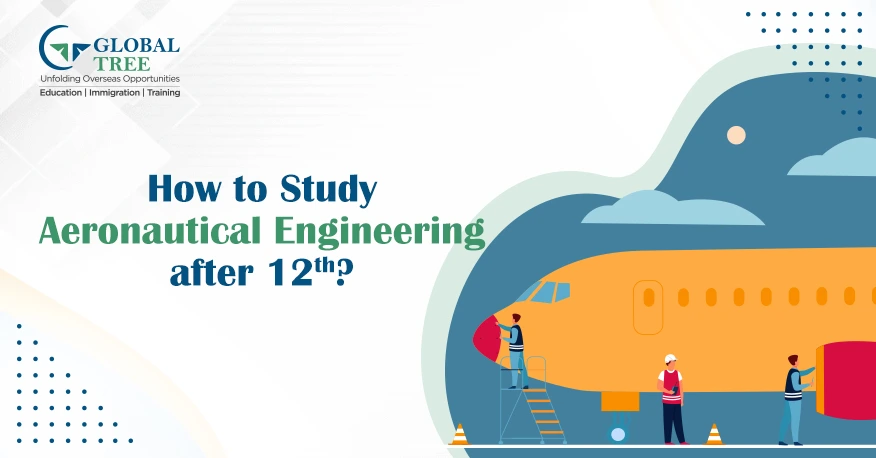How to Study Aeronautical Engineering after 12th? For a Soaring Career in Aviation

- Introduction
- What Is Aeronautical Engineering?
- Skill Required for an Aeronautical Engineering Career After 12th
- Aeronautical Engineering Course Options after 12th
- List of Aeronautical Engineering Courses After 12th
- Aeronautical Engineering Courses after 12th Abroad
- What is the Eligibility Criteria for Aeronautical Engineering Courses After 12th?
- Entrance Exams Abroad for Aeronautical Engineering
- How to Study Aeronautical Engineering after 12th Abroad?
- In-Demand Career Prospects in Aeronautical Engineering in India
- Trending Career Prospects in Aeronautical Engineering Abroad
- What is the scope of Aeronautical Engineering Abroad?
- Aeronautical Engineering Salary Abroad
- Touching Down!
Introduction
Embarking on the journey to become an aeronautical engineer straight out of 12th grade is a thrilling leap into the dynamic world of aviation and technology.
Aeronautical engineering unravels the intricacies of aircraft design, maintenance, and innovation.
This comprehensive guide will walk you through the steps, options, and opportunities available for aspiring aeronautical engineers in both India and abroad.
What Is Aeronautical Engineering?
Aeronautical engineering involves applying engineering principles to the design, development, and maintenance of aircraft and spacecraft. Positioned at the forefront of aviation, this field focuses on aerodynamics, propulsion systems, and flight mechanics, playing a pivotal role in shaping the future of air travel.
Skill Required for an Aeronautical Engineering Career After 12th
To navigate the skies of aeronautical engineering successfully, certain skills are essential. Strong mathematical and analytical abilities, attention to detail, problem-solving skills, and a passion for aviation are key. Effective communication skills and teamwork are also vital, given the collaborative nature of aeronautical engineering projects.
Aeronautical Engineering Course Options after 12th
Following the completion of 12th grade, Indian students can choose from a variety of courses in the field of aeronautical engineering. Let's delve into the diverse options available, each offering a unique perspective on the fascinating world of aviation.
Aeronautical Engineering Courses after 12th in India
| S.No. | Course | Duration |
|---|---|---|
|
1 |
B.Tech in Aeronautical Engineering |
4 years |
|
2 |
B.Sc in Aeronautics |
3 years |
|
3 |
Diploma in Aeronautical Engineering |
3 years |
|
4 |
B.Tech in Aerospace Engineering |
4 years |
|
5 |
B.E in Aeronautical Engineering |
4 years |
|
6 |
B.Sc in Aviation |
3 years |
|
7 |
B.Tech in Aircraft Maintenance Engineering |
3 years |
|
8 |
B.E in Aerospace Technology |
4 years |
|
9 |
B.Tech in Avionics Engineering |
4 years |
|
10 |
B.Tech in Aerospace Propulsion |
4 years |
(Read More: STEM Courses to study in the USA for Indians)
Aeronautical Engineering Courses after 12th Abroad
| Sr.No. | Course | Duration |
|---|---|---|
|
1 |
B.Eng in Aerospace Engineering (USA) |
4 years |
|
2 |
B.Eng in Aeronautical Engineering (UK) |
3 years |
|
3 |
B.Eng in Aerospace Engineering (Canada) |
4 years |
|
4 |
B.Eng in Aerospace Systems Engineering (Germany) |
3 years |
|
5 |
B.Tech in UAV Engineering (USA) |
4 years |
|
6 |
B.Eng in Astronautical Engineering (Russia) |
5 years |
|
7 |
B.Eng in Aerospace Engineering (Australia) |
4 years |
|
8 |
B.Sc in Aviation Technology (USA) |
3 years |
|
9 |
B.Tech in Aerospace Systems (UK) |
3 years |
|
10 |
B.Sc in Aerospace Engineering (Canada) |
4 years |
List of Aeronautical Engineering Courses After 12th
Bachelor of Technology (B.Tech) in Aeronautical Engineering
Duration: 4 years
Overview: Comprehensive program covering aerodynamics, aircraft structures, propulsion systems, preparing students for a career in aircraft design and development.
Bachelor of Science (B.Sc) in Aeronautics
Duration: 3 years
Overview: Focuses on the scientific aspects of aviation, covering aircraft systems, avionics, and aerospace materials, providing a broad understanding of the field.
Diploma in Aeronautical Engineering
Duration: 3 years
Overview: Practical and concise option for hands-on experience, covering essential aspects of aircraft systems and maintenance.
Bachelor of Technology (B.Tech) in Aerospace Engineering
Duration: 4 years
Overview: Specialized choice aligned with aeronautics, covering aerodynamics, aircraft structures, and propulsion systems.
Bachelor of Engineering (B.E) in Aeronautical Engineering
Duration: 4 years
Overview: In-depth program focusing on core aeronautical engineering principles and applications.
Bachelor of Science (B.Sc) in Aviation
Duration: 3 years
Overview: Explores various facets of aviation, including navigation, airport management, and air traffic control.
Bachelor of Technology (B.Tech) in Aircraft Maintenance Engineering
Duration: 3 years
Overview: Specialized program focusing on the maintenance and repair aspects of aircraft.
Bachelor of Engineering (B.E) in Aerospace Technology
Duration: 4 years
Overview: Integrates technology and engineering principles with a focus on aerospace applications.
Bachelor of Technology (B.Tech) in Avionics Engineering
Duration: 4 years
Overview: Concentrates on aviation electronics, covering the design and maintenance of avionic systems in aircraft.
Bachelor of Technology (B.Tech) in Aerospace Propulsion
Duration: 4 years
Overview: Specialized program focusing on aircraft propulsion systems, including engines and related technologies.
Aeronautical Engineering Courses after 12th Abroad
Bachelor of Aerospace Engineering (USA)
Duration: 4 years
Overview: Comprehensive program covering aircraft design, propulsion, and space exploration, renowned for the aerospace industry in the USA.
Bachelor of Aeronautical Engineering (UK)
Duration: 3 years
Overview: Unique perspective on aeronautics with a strong emphasis on research and innovation, preparing students for a dynamic career.
Bachelor of Engineering in Aerospace Engineering (Canada)
Duration: 4 years
Overview: Emphasizes practical skills and exposure to cutting-edge aerospace technologies, offering a well-rounded education.
(Read More: Future prospects of studying in Canada after12th)
Bachelor of Engineering (B.E) in Aerospace Systems Engineering (Germany)
Duration: 3 years
Overview: Germany's program emphasizes systems engineering principles in the context of aerospace applications.
Bachelor of Technology (B.Tech) in Unmanned Aerial Vehicle (UAV) Engineering
Duration: 4 years
Overview: Focuses on the engineering aspects of unmanned aerial vehicles, including design, navigation, and control systems.
Bachelor of Engineering in Astronautical Engineering (Russia)
Duration: 5 years
Overview: Specialized program in astronautical engineering, covering aspects related to space exploration and spacecraft design.
Bachelor of Engineering in Aerospace Engineering (Australia)
Duration: 4 years
Overview: Comprehensive program with a focus on practical skills and innovation in aerospace engineering.
Bachelor of Science (B.Sc) in Aviation Technology (USA)
Duration: 3 years
Overview: Covers various aspects of aviation technology, including avionics and navigation systems.
Bachelor of Technology (B.Tech) in Aerospace Systems (UK)
Duration: 3 years
Overview: Focuses on aerospace systems, combining engineering principles with technology applications.
Bachelor of Science (B.Sc) in Aerospace Engineering (Canada)
Duration: 4 years
Overview: Explores the fundamental principles of aerospace engineering with a focus on aircraft and spacecraft design.
Diploma in Aeronautical Engineering
Duration: 3 years
Overview: A practical and concise option for those seeking hands-on experience in aeronautical engineering. The program covers essential aspects of aircraft systems and maintenance, making graduates industry-ready.
What is the Eligibility Criteria for Aeronautical Engineering Courses After 12th?
To enroll in aeronautical engineering courses after 12th in India, students generally need to meet the following eligibility criteria:
Educational Qualifications
Successful completion of 10+2 with a strong background in physics, chemistry, and mathematics.
Entrance Exams
Entrance exams play a crucial role in securing admission to top aeronautical engineering institutes. In India, some of the prominent entrance exams include:
Joint Entrance Examination (JEE) Main
Conducted by the National Testing Agency (NTA), JEE Main is a widely accepted entrance exam for various engineering disciplines, including aeronautical engineering.
Joint Entrance Examination (JEE) Advanced
JEE Advanced is the next level of the JEE Main exam, and it is necessary for admission to prestigious institutes like the Indian Institutes of Technology (IITs).
(Read More: How to ace the Entrance tests to get into best universities?)
BITSAT (Birla Institute of Technology and Science Admission Test)
BITSAT is the entrance exam for admission to integrated first-degree programs at BITS Pilani, including aerospace engineering.
SRMJEEE (SRM Joint Engineering Entrance Examination)
SRMJEEE is the entrance exam for admission to engineering programs at SRM Institute of Science and Technology.
VITEEE (VIT Engineering Entrance Examination)
VITEEE is the entrance exam for admission to engineering programs at Vellore Institute of Technology (VIT).
Entrance Exams Abroad for Aeronautical Engineering
For international education in aeronautical engineering, entrance exams are often required. Some widely recognized exams include:
SAT (Scholastic Assessment Test)
Many universities in the United States and other countries accept SAT scores for admission.
ACT (American College Testing)
Similar to SAT, ACT scores are widely accepted by U.S. universities.
GRE (Graduate Record Examination)
Some universities, especially for postgraduate programs, may require GRE scores.
IELTS (International English Language Testing System) or TOEFL (Test of English as a Foreign Language)
English proficiency tests are often mandatory for non-native English speakers.
GATE (Graduate Aptitude Test in Engineering)
For postgraduate programs, GATE scores are accepted by some institutes in India and abroad.
How to Study Aeronautical Engineering after 12th Abroad?
For Indian students aspiring to pursue international education in aeronautical engineering, the process involves several essential steps:
Researching Universities
Identify universities globally recognized for their aeronautical engineering programs. Consider factors such as faculty expertise, research opportunities, and alumni success.
Entrance Exams and Application Process
Many international universities, especially in the United States, may require standardized test scores such as SAT or ACT. It's crucial to ensure timely completion of applications, including transcripts and recommendation letters.
Visa Process
Once accepted into a foreign university, navigate the visa application process diligently. Pay attention to deadlines and ensure all required documentation is submitted.
Adapting to a New Culture
Prepare for a cultural shift by researching the host country's lifestyle, academic expectations, and local customs. Engage with international student communities for support and guidance.
(Read More: How to calculate your CGPA in Engineering?)
In-Demand Career Prospects in Aeronautical Engineering in India
Aeronautical engineers in India can explore diverse career options, including but not limited to:
Aircraft Design and Manufacturing
Work with aerospace companies involved in designing and manufacturing aircraft. This role involves translating conceptual designs into functional aircraft.
Maintenance and Repair
Ensure the safe and efficient functioning of aircraft by working in maintenance and repair roles. Aeronautical engineers in this field play a critical role in keeping aviation systems operational.
Research and Development
Contribute to advancements in aerospace technology by engaging in research and development projects. This involves pushing the boundaries of innovation in aircraft design, propulsion, and materials.
Air Traffic Control
Aeronautical engineers may work in air traffic control, ensuring the safe and efficient movement of aircraft within controlled airspace.
Aerospace Software Development
With the increasing reliance on technology, aeronautical engineers can explore careers in aerospace software development, designing software for aircraft systems.
Trending Career Prospects in Aeronautical Engineering Abroad
Internationally, aeronautical engineers can pursue exciting opportunities abroad, such as:
Space Exploration
Contribute to space missions and exploration with organizations like NASA or the European Space Agency. Aeronautical engineers may work on designing spacecraft or developing technologies for space exploration.
Aviation Consultancy
Provide expertise to aviation companies globally, advising on aircraft design, safety, and compliance. Aeronautical engineers in consultancy roles play a crucial part in ensuring adherence to international aviation standards.
Aerospace Project Management
Manage complex aerospace projects, overseeing the design, development, and implementation of aircraft systems.
Government Aerospace Agencies
Work with government aerospace agencies, participating in national and international projects related to aviation and space exploration.
Unmanned Aerial Vehicle (UAV) Industry
Explore opportunities in the growing UAV industry, working on the design and implementation of unmanned aerial systems.
What is the scope of Aeronautical Engineering Abroad?
The global demand for skilled aeronautical engineers continues to rise, creating a broad scope for career growth. Countries like the USA, UK, Germany, and Canada offer diverse opportunities in both the private and public sectors.
Aeronautical Engineering Salary Abroad
Salaries for aeronautical engineers abroad vary based on experience, education, and location. On average, entry-level positions offer competitive salaries, with the potential for significant increases as professionals gain experience. Here's an overview of entry-level salaries in popular countries:
United States
Entry-level aeronautical engineers in the USA can expect an annual salary ranging from $60,000 to $80,000.
United Kingdom
Entry-level salaries for aeronautical engineers typically range from £25,000 to £35,000 per year.
Canada
Entry-level aeronautical engineers in Canada can earn an annual salary ranging from CAD 50,000 to CAD 70,000.
(Read More: Top Highest-paying jobs in Canada for international students)
Germany
Entry-level salaries for aeronautical engineers in Germany range from €40,000 to €50,000 per year.
Touching Down!
Embarking on the journey to become an aeronautical engineer after 12th is a thrilling endeavor that opens doors to a world of innovation and technology.
Whether choosing a path in India or exploring international opportunities, the field of aeronautical engineering promises an exciting and rewarding career.
Stay curious, stay focused, and let your passion for aviation take flight! With countless opportunities to explore and a world of possibilities ahead, the sky is not the limit—it's just the beginning.









